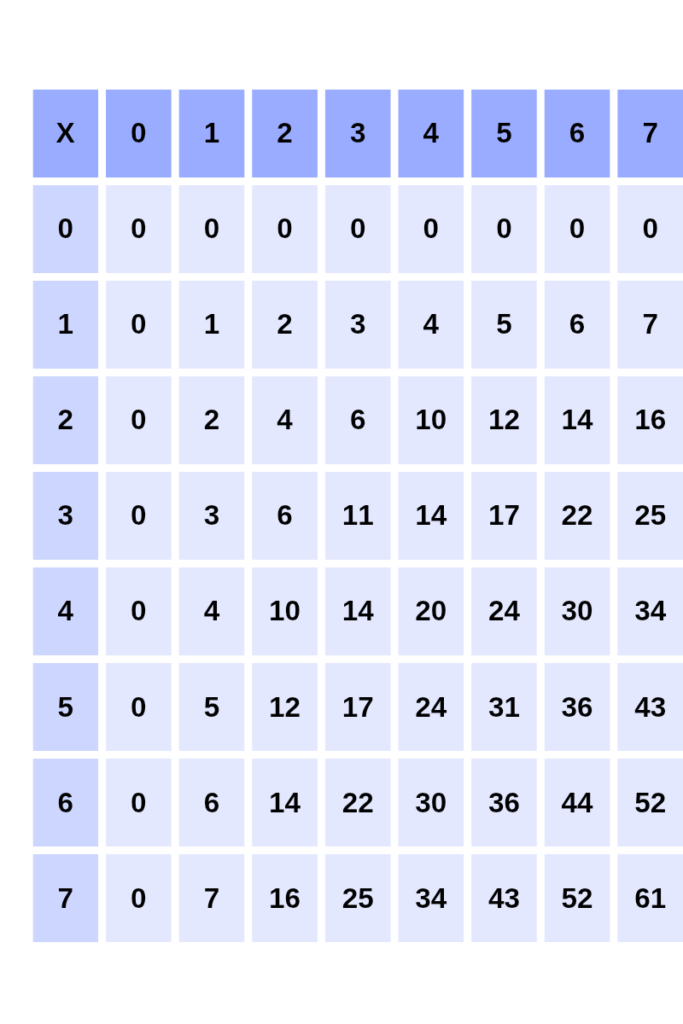This is my third article on octal number system arithmetic. In this article I am going to explain octal numbers multiplication. I will also discuss multiplication using octal multiplication table.There are my posts on octal addition, octal subtraction and octal division
Key Questions:
- How to perform multiplication in octal number system?
- How to perform fractional octal numbers multiplication?
- Discuss octal multiplication table

Octal Numbers Multiplication Examples:
The multiplication process of octal numbers are same as other number systems. You can verify your result by using this online converter.
The points you should keep in mind while multiplying octal numbers:
- If the sum exceeds 7 ( 0,1,2,3,4,5,6,7) you need to evaluate the equivalent octal value.
- Divide the number by 8 and find its equivalent octal value. Quotient is going to be carry while remainder taken as sum.
- Have a look at this simple example below.

Example # 01: 777)8*33)8
7 7 7
× 3 3
---------
2 7 7 5
+ 2 7 7 5 x
-----------
3 2 7 4 5
------------
For calculations check the table below 👇
| Decimal | Octal equivalent | Sum/ remainder | Carry/ quotient | |
| 7*3 | 21 | 21÷8=25 | 5 | 2 |
| 7*3 | 21+2 | 23÷8=27 | 7 | 2 |
| 7*3 | 21+2 | 23÷8=27 | 7 | 2 |
| 7+5 | 12 | 12÷8=14 | 4 | 1 |
| 7+7+1 | 15 | 15÷8=17 | 7 | 1 |
| 2+7+1 | 10 | 10÷8=12 | 2 | 1 |
This is my third article on octal number system arithmetic. In this article I am going to explain octal numbers multiplication. I will also discuss multiplication using octal multiplication table.There are my posts on octal addition and octal subtraction.
Key Questions:
-
How to perform multiplication in octal number system?
-
How to perform fractional octal numbers multiplication?
-
Discuss octal multiplication table
Octal Number System Multiplication Table:
|
X
|
0
|
1
|
2
|
3
|
4
|
5
|
6
|
7
|
|
0
|
0
|
0
|
0
|
0
|
0
|
0
|
0
|
0
|
|
1
|
0
|
1
|
2
|
3
|
4
|
5
|
6
|
7
|
|
2
|
0
|
2
|
4
|
6
|
10
|
12
|
14
|
16
|
|
3
|
0
|
3
|
6
|
11
|
14
|
17
|
22
|
25
|
|
4
|
0
|
4
|
10
|
14
|
20
|
24
|
30
|
34
|
|
5
|
0
|
5
|
12
|
17
|
24
|
31
|
36
|
43
|
|
6
|
0
|
6
|
14
|
22
|
30
|
36
|
44
|
52
|
|
7
|
0
|
7
|
16
|
25
|
34
|
43
|
52
|
61
|
Octal Number System Multiplication Examples:
The multiplication process of octal numbers are same as other number systems. You can verify your result by using this online converter.The points you should keep in mind while multiplying octal numbers:
-
If the sum exceeds 7 ( 0,1,2,3,4,5,6,7) you need to evaluate the equivalent octal value.
-
Divide the number by 8 and find its equivalent octal value. Quotient is going to be carry while remainder taken as sum
For example 5)8*6)8=30)10
5
*6
36)8
3 ← quotient as carry
8⟌30
24
6 ← remainder as sum
Example#01:777)8*33)8
2 2 ← carry
7 7 7
*33
1 1 1 ← carry
2 7 7 5
2 7 7 5 X
3 2 7 4 5
|
Decimal
|
Octal equivalent
|
Sum/remainder
|
Carry/quotient
|
|
|
7*3
|
21
|
21÷8=25
|
5
|
2
|
|
7*3
|
21+2
|
23÷8=27
|
7
|
2
|
|
7*3
|
21+2
|
23÷8=27
|
7
|
2
|
|
7+5
|
12
|
12÷8=14
|
4
|
1
|
|
7+7+1
|
15
|
15÷8=17
|
7
|
1
|
|
2+7+1
|
10
|
10÷8=12
|
2
|
1
|
Answer: 32745)8
Example#02:466.4)8*2.7)8
1 1 1
5 5 3
4 6 6 . 4
*2 . 7
1
4 1 7 5 4
1 1 5 5 0 X
1 5 7 4. 5 4
|
Decimal
|
Octal equivalent
|
Sum/remainder
|
Carry/quotient
|
|
|
7*4
|
28
|
28÷8=24
|
4
|
2
|
|
7*6
|
42+3
|
45÷8=5
|
5
|
5
|
|
7*6
|
42+5
|
47÷8=47
|
7
|
4
|
|
7*4
|
28+5
|
33÷8=41
|
1
|
4
|
|
2*4
|
8
|
8÷8=10
|
0
|
1
|
|
2*6
|
12+1
|
13÷8=15
|
5
|
1
|
|
2*6
|
12+1
|
13÷8=15
|
5
|
1
|
|
2*4
|
8+1
|
9÷8=11
|
1
|
1
|
|
7+5
|
12
|
12÷8=14
|
6
|
1
|
Answer:1574.54)8
Example#03:3636)8*741)8
Let’s try to solve an example using octal multiplication table.
X=3636
Y=741
1*6 find the intersection of 3 and 6. Which is 6. Similarly for all the products refer table.
5 3 5
3 1 3
3 6 3 6
*7 4 1
1 1
3 6 3 6
1 7 1 7 0 X
3 2 5 2 2 X X
3 4 4 7 7 3 6
Answer: 3447736)8
Conclusion:
This is all about octal numbers multiplication. I verified and checked all the answers and solutions. If you still find any logical or typographical mistake, please inform me. If you find this post helpful, please like it.

Fin
Unknown
Syeda Amna Ahmed